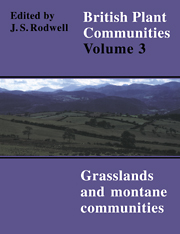Book contents
- Frontmatter
- Contents
- List of Figures
- Preface and Acknowledgements
- Preamble
- Mesotrophic Grasslands
- Community Descriptions
- Calcicolous Grasslands
- Community Descriptions
- Calcifugous Grasslands and Montane Communities
- Community Descriptions
- Index of Synonyms to Grasslands and Montane Communities
- Index of Species in Grasslands and Montane Communities
- Bibliography
CG10 - Festuca Ovina-Agrostis Capillaris-Thymuspraecox Grassland
Published online by Cambridge University Press: 04 July 2020
- Frontmatter
- Contents
- List of Figures
- Preface and Acknowledgements
- Preamble
- Mesotrophic Grasslands
- Community Descriptions
- Calcicolous Grasslands
- Community Descriptions
- Calcifugous Grasslands and Montane Communities
- Community Descriptions
- Index of Synonyms to Grasslands and Montane Communities
- Index of Species in Grasslands and Montane Communities
- Bibliography
Summary
Synonymy
Agrostis-Festuca grassland auct. angl. p.p.; Basic grassland Ratcliffe 1959; Species-rich Agrosto-Festucetum McVean & Ratcliffe 1962; Saxifrageto-Agrosto-Festucetum McVean & Ratcliffe 1962; Festuca ovinal Agrostis tenuis Type D grassland King 1962; Festuca-Agrostis Type 9 grassland King & Nicholson 1964; Festuco-Poetum Shimwell 1968a p.p.; Herb-rich Agrostis-Festuca grassland Ward et al. 1972; Festuco-Nar de turn Jones 1973 p.p.; Achilleo-Festucetum tenuifoliae Birse & Robertson 1976; Thymo-Agrosto-Festucetum Evans et al. 1977; Trifolio-Agrosto-Festucetum Evans et al. 1977p.p.; Thymo-Festucetum boreale Evans et al. 1977 p.p.; Viola-Festuca-Agrostis nodum Huntley 1979 p.p.; Galium sterneri-Helictotrichon pratense community Birse 1980; Galium verum-Koeleria cristata community Birse 1980.
Constant species
Agrostis capillaris, Campanula rotundifolia, Festuca ovina, F. rubra, Plantago lanceolata, Potentilla erecta, Prunella vulgaris, Thymus praecox, Viola riviniana, Hylocomium splendens.
Rare species
Alchemilla filicaulis ssp. filicaulis, A. wichurae, Carex capillaris, C. montana, C. rupestris, Draba incana, Galium sterneri, Minuartia verna, Myosotis alpestris, Omalotheca supina, Sagina saginoides, Salix herbacea, Sibbaldia procumbens, Tofieldia pusilia.
Physiognomy
The Festuca-Agrostis-Thymus grassland occurs as generally closed swards, often close-cropped by heavy grazing, in which the most obvious distinguishing feature, compared with the Sesleria albicans grasslands and lowland calcicolous communities, is the consistent prominence of various Nardo-Galion species. Among the grasses, for example, Agrostis capillaris is as frequent and abudant as Festuca ovina (sometimes recorded here as F. tenuifolia but rarely as F. vivipara) and these two species together often comprise the basis of the turf. Festuca rubra is also very frequent, though it is usually not so abundant as F. ovina. Common, too, but somewhat unevenly represented in the different subcommunities, are Nardus stricta, Anthoxanthum odoratum and Danthonia decumbens and each of these can also be locally prominent. Much more patchy and rarely at high cover are Poa pratensis I subcaerulea (inadequately distinguished in some data), in drier stands Agrostis canina ssp. montana and Deschampsiaflexuosa and in damper sites A. canina spp. canina and D. cespitosa.
Some sedges are frequently present but, again, there is a shift in emphasis among these species as compared with lowland swards. Carexflacca, for example, is never more than occasional and C. caryophyllea, though frequent in one sub-community, is scarce in the others.
- Type
- Chapter
- Information
- British Plant Communities , pp. 234 - 245Publisher: Cambridge University PressPrint publication year: 1992



